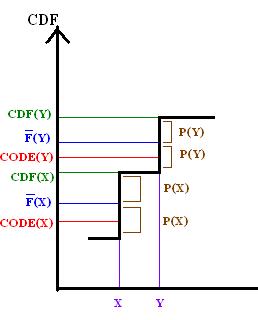Shannon–Fano–Elias coding on:
[Wikipedia]
[Google]
[Amazon]
In information theory, Shannon–Fano–Elias coding is a precursor to
 By definition of ''L'' it follows that
:
And because the bits after ''L''(''y'') are truncated from ''F''(''y'') to form code(''y''), it follows that
:
thus bcode(''y'') must be no less than CDF(''x'').
So the above graph demonstrates that the , therefore the prefix property holds.
By definition of ''L'' it follows that
:
And because the bits after ''L''(''y'') are truncated from ''F''(''y'') to form code(''y''), it follows that
:
thus bcode(''y'') must be no less than CDF(''x'').
So the above graph demonstrates that the , therefore the prefix property holds.
Thus for ''H''(''X''), the
arithmetic coding
Arithmetic coding (AC) is a form of entropy encoding used in lossless data compression. Normally, a string of characters is represented using a fixed number of bits per character, as in the ASCII code. When a string is converted to arithmetic ...
, in which probabilities are used to determine codewords.
Algorithm description
Given adiscrete random variable
A random variable (also called random quantity, aleatory variable, or stochastic variable) is a mathematical formalization of a quantity or object which depends on random events. It is a mapping or a function from possible outcomes (e.g., the po ...
''X'' of ordered values to be encoded, let be the probability for any ''x'' in ''X''. Define a function
:
Algorithm:
:For each ''x'' in ''X'',
::Let ''Z'' be the binary expansion of .
::Choose the length of the encoding of ''x'', , to be the integer
::Choose the encoding of ''x'', , be the first most significant bit
In computing, bit numbering is the convention used to identify the bit positions in a binary number.
Bit significance and indexing
In computing, the least significant bit (LSB) is the bit position in a binary integer representing the binar ...
s after the decimal point of ''Z''.
Example
Let ''X'' = , with probabilities ''p'' = . :For ''A'' :: ::In binary, ''Z''(''A'') = 0.0010101010... :: ::code(''A'') is 001 :For ''B'' :: ::In binary, ''Z''(''B'') = 0.01110101010101... :: ::code(''B'') is 011 :For ''C'' :: ::In binary, ''Z''(''C'') = 0.101010101010... :: ::code(''C'') is 1010 :For ''D'' :: ::In binary, Z(D) = 0.111 :: ::code(''D'') is 111Algorithm analysis
Prefix code
Shannon–Fano–Elias coding produces a binaryprefix code A prefix code is a type of code system distinguished by its possession of the "prefix property", which requires that there is no whole code word in the system that is a prefix (initial segment) of any other code word in the system. It is trivially t ...
, allowing for direct decoding.
Let bcode(''x'') be the rational number formed by adding a decimal point before a binary code. For example, if code(''C'') = 1010 then bcode(''C'') = 0.1010. For all ''x'', if no ''y'' exists such that
:
then all the codes form a prefix code.
By comparing ''F'' to the CDF of ''X'', this property may be demonstrated graphically for Shannon–Fano–Elias coding.
 By definition of ''L'' it follows that
:
And because the bits after ''L''(''y'') are truncated from ''F''(''y'') to form code(''y''), it follows that
:
thus bcode(''y'') must be no less than CDF(''x'').
So the above graph demonstrates that the , therefore the prefix property holds.
By definition of ''L'' it follows that
:
And because the bits after ''L''(''y'') are truncated from ''F''(''y'') to form code(''y''), it follows that
:
thus bcode(''y'') must be no less than CDF(''x'').
So the above graph demonstrates that the , therefore the prefix property holds.
Code length
The average code length is .Thus for ''H''(''X''), the
entropy
Entropy is a scientific concept, as well as a measurable physical property, that is most commonly associated with a state of disorder, randomness, or uncertainty. The term and the concept are used in diverse fields, from classical thermodynam ...
of the random variable ''X'',
:
Shannon Fano Elias codes from 1 to 2 extra bits per symbol from ''X'' than entropy, so the code is not used in practice.
References
{{DEFAULTSORT:Shannon-Fano-Elias coding Lossless compression algorithms